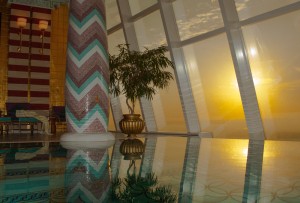Successfully executed architecture— bigger, better, higher—make it necessary to drop by every few years to view the changing cityscape.
by Donna Peck

The world’s remarkable cities never fail to satisfy. Dubai has earned a foothold in the history of our time for its visionary architecture.
Before 1967 Dubai was a trading post on the Persian Gulf, a fishing village with thatched huts and a protectorate of the British Empire.
Since then, a massive steel-and-glass oasis has sprouted. Emerging from a five-year slowdown, development reinvigorated, the city is worth a stop, even if you need to reroute your fight.
The view from my hotel verandah at Raffles hotel revealed a skyline of impossibly tall buildings. In the center, the silver shaft of the half-mile-high Burj Khalifa pierced the morning mist.

Dubai encompasses a set of mini cities, each with a different theme executed by a different architectural firm for different purposes. WaFi City pays homage to ancient Egypt, the passion of the sheik financier. The hotel is pyramid-shaped, Isis spreads gold wings on lobby walls, the stone eye of Horus adorns a garden path. Corridors in the underground mall are devoted to Egyptian bric-a-brac, hookah pipes and embroidered caftans.
The Emiratis parlayed oil revenues and the preponderance of sand into real estate. Dredging and sand-fill created off-shore islands, adding 88 square miles to the original land mass. Then they filled it with no-holds-barred architecture much of it for the pleasure of hotel guests.
The Burg Al-Arab, tower of the Arabs
From a distance The Burg Al-Arab looks like a billowing mainsail. The massive hotel, the city’s icon, sits on a small off-shore island. Once inside, it still appears to billow from its base in the lobby atrium to the top. I looked up, marveling at the sail, made of fiber-reinforced Teflon and the cross beam supports.

Tiered corridors that look like decks, flank the atrium. During check-in, butlers escort guests down these corridors to palatial two-story suites.
Not many leave the property. Sitting in 18th floor lounge after a sunrise swim in the infinity pool, I felt a current of fresh air slip in around the sail’s corners. The elevator to the top floor deposits guests at a crow’s-nest-like restaurant with an outdoor viewing deck. I surveyed the islands under construction. Palm Jumeirah, on the left, is one of three palm-shaped islands. The shape is clearly defined with 17 fronds and a crescent island that serves as a breakwater. On the right is the World with islands roughly the shape of continents.
The Atlantis
The Atlantis rises like an Arabian fortress on an island further off-shore, connected to the mainland by a slender causeway. A rosy morning softened its appearance but I still felt like my taxi was crossing a gangway.
True to its name, the Atlantis is dedicated to the expression and enjoyment of water.
The centerpiece of the hotel/theme park is a large, sprawling, three-story aquarium with exhibits of an imagined Atlantis. In the main exhibit hall, groupers, sharks and sting rays circle the roman ruins like pirates patrolling a pillaged city.

Visitors stand opposite the glass in a trance. Sea horses bounce, jellyfish dangle deadly tentacles. Moray eels slither through broken pottery and angelfish pluck algae from the toppled columns. I emerged from the labyrinthine Lost Chamber exhibit to the water park, with chutes, waterfalls and a meandering creek shaded by palm trees. The beach path was also richly landscaped. But the beach—white and inviting from a distance—had a hard surface because it was made of crushed shell and coral sand.
Nothing is scarcer in a desert than water. Ice is unimaginable. Dubai has no natural river bodies or oases, and stifling heat. Yet here you find a three-story aquarium, a garden with 45 million flowers in bloom (but not year-round), indoor ski runs and an ice bar of sculpted ice (shipped from Ontario in refrigerated containers). Yes, I wondered, too.
Sand sports
The city has pulled off the illusion that it is not in the Arabian desert, nor does sand lap at its edges. East of the city, beyond the salt-crusted coastal plains, sabkha: the flat land gives way to high dunes as far as the eye can see.
Not a depressing sight if you have a dune buggy hitched to your car. The dunes rumble like a racetrack on Saturday evenings. Middle-class families bash up and down the sand hills in custom dune buggies. Scores of tour operators take tourists out for high-speed chases.
I was assigned to an expert dune basher, Ali, in a red Toyota. The SUVs and buggies formed a line, then dropped down the steep face of a dune. Engines revving, sand flying, we climbed back up, reached the ridge, then bashed down again. We traversed the entire canyon, arriving at sunset to a plateau. Picnic baskets emerged and all was quiet as the sky glowed and the dunes darkened.
Pre-modern Dubai
Also curious are the remaining elements of pre-developed Dubai. People cross Dubai Creek on a pedestrian barge. Fishermen unload their catch from dhows in the early morning. Gold jewelers and spice merchants entertain shoppers in their stalls at the Deira souk.
Dubai Museum preserves a romanticized version of a trading-post, fishing village. In the courtyard, a summer house built on stilts off the ground shows how people managed to catch an occasional breeze. In a diorama, pearl fishermen unload sacks of oysters, a reminder of the pearl harvest that brought traders to the largely ignored southern shores of the Persian Gulf.
The spotlight is unlikely to sputter and die. The city continues to invent ways to give prominence to itself. As you read this; bigger, better, higher marvels are being planned for the 2020 World Expo.

If you stay at the Burg Al-Arab, request a corner room. It’s lifetime thrill.
Text and photography by Donna Peck






Leave a Reply